The new ETS2 is a make-or-break element of the European climate architecture. If its implementation is significantly delayed or the system is substantially weakened, it could cause collateral damage to the credibility of ETS1 and the entire EU climate policy. This would also result in permanent delays or complete cessation of investments in emission reductions.
A renegotiation of the directive to adjust market rules before the start of trading with certificates in 2027 should be avoided, as the currently highly politicized but poorly informed process poses the risk of substantial weakening of the directive. Safeguard measures to prevent this could include improving the consultation process (especially for member states) and cushioning a sharp rise in ETS2 prices and unexpected price spikes, particularly in the early years.
Political pressure from member states could still lead to the directive being opened now to inject additional certificates into the market in anticipation of sharply rising prices. This would keep prices and investments in emission reductions permanently at too low a level, undermining the long-term credibility of the policy. Consequently, additional safeguard measures would be needed to prevent the accumulation of surplus certificates and thus reduce the legal certainty of the entire ETS.
The credibility of ETS2 can be enhanced through complementary measures that specifically reduce medium- to long-term price uncertainty (de-risking). Providers of climate-friendly technologies and energy service providers are generally best placed to assess how high and differentiated the risk reduction needs to be for different customer groups based on their market knowledge. Therefore, the political priority should be to support corresponding entrepreneurial initiatives in a competitive and as revenue-neutral a framework as possible.
The credibility of ETS2 can also be underpinned by using auction revenues for social compensation. However, political prioritization must be such that the introduction and scaling up of ETS2 is facilitated (rightsizing). At the European level, a reform of the Climate Social Fund (KSF) would be necessary so that transfer payments to particularly affected countries increase when the ETS2 price rises. At the national level, social security measures should also be adjusted to scale with the ETS2 price. Measures and funds from the KSF and other ETS2 revenues should be used to support vulnerable households outside the social security system.
Read the entire study: „Wie weiter mit dem ETS2? Vorschläge und Erwägungen zur Umsetzung und Stärkung der Glaubwürdigkeit“ here as a PDF. Please note, to date the analysis is only available in German.


